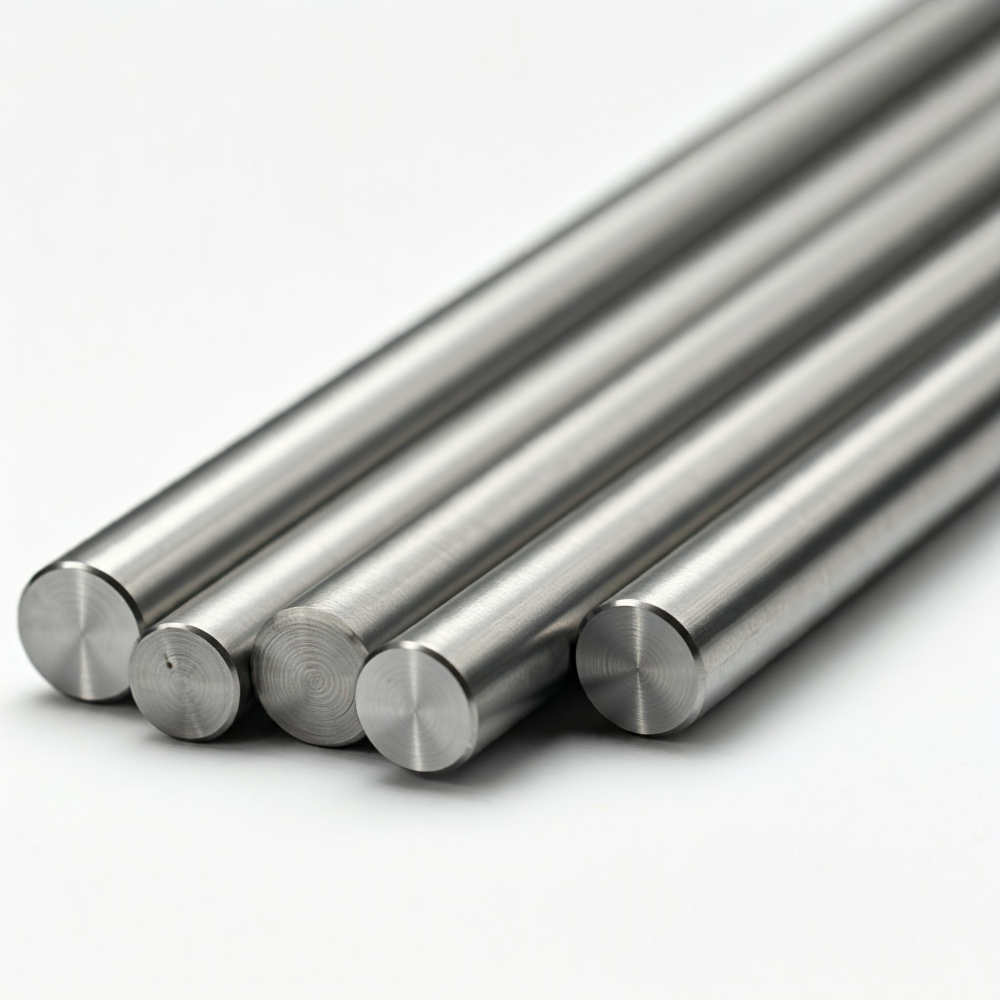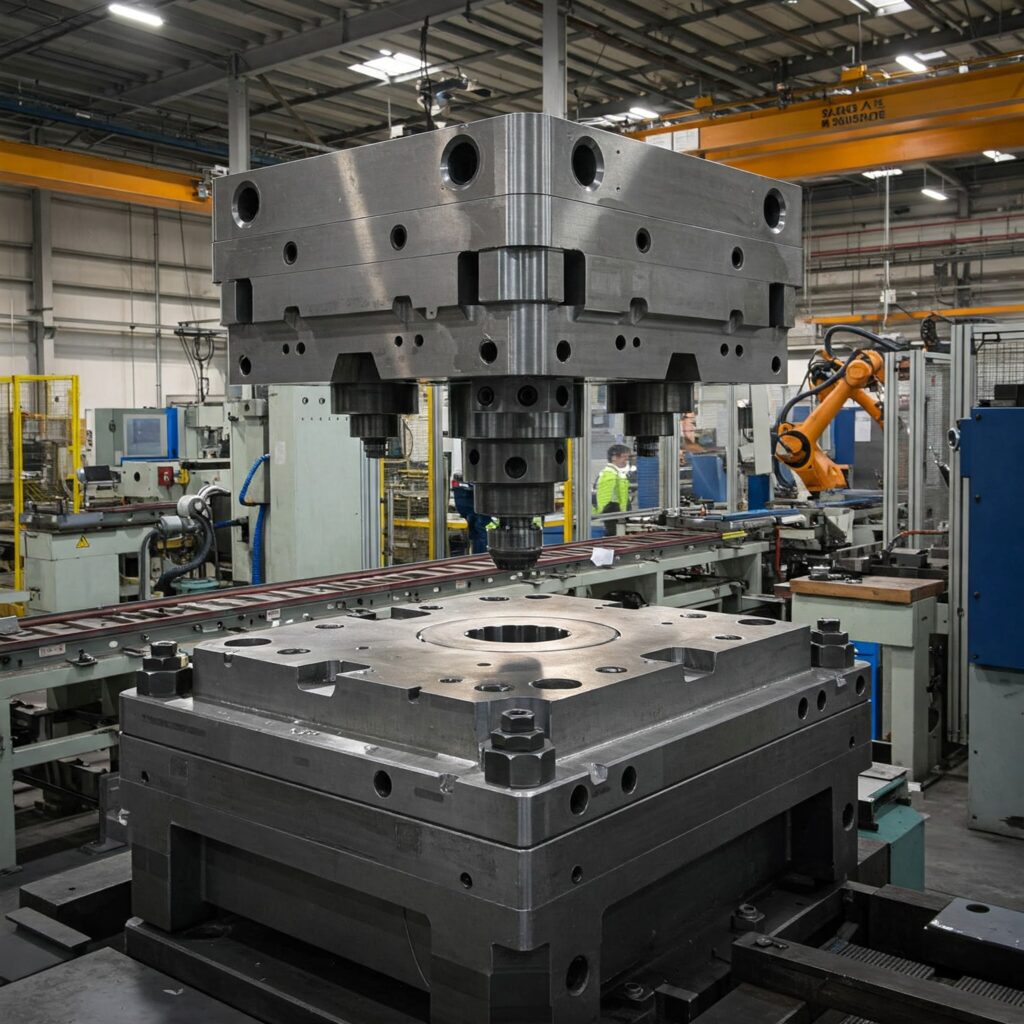Acero para herramientas H11 y Acero para herramientas H13 Ambos son aceros para herramientas de trabajo en caliente. Pertenecen a la serie H del sistema ASTM (Sociedad Americana para Pruebas y Materiales).
El H11 y el H13 son representativos de los aceros para herramientas de trabajo en caliente. Ofrecen una buena relación calidad-precio, lo que los convierte en un referente para diversas aplicaciones en moldes de conformado en caliente. Estos materiales se desarrollaron inicialmente para la fundición a presión y presentan alta templabilidad, mínima deformación durante el tratamiento térmico, mínima tendencia a la oxidación, buen rendimiento de revenido, resistencia a la corrosión del aluminio líquido y alta resistencia a la fatiga térmica.
La principal diferencia entre el acero H11 y el H13 radica en que el H13 contiene aproximadamente 0,51 TP3T más de vanadio. Este contenido adicional de vanadio aumenta aún más la dureza en caliente y la resistencia al revenido, pero también puede reducir ligeramente la tenacidad, especialmente durante el temple y el revenido.
El H13 presenta una resistencia ligeramente superior al ablandamiento tras el tratamiento térmico, pero su tenacidad es ligeramente inferior. En comparación con el H11, el H13 puede presentar una distribución desigual de carburos de vanadio. Esto es especialmente importante en condiciones de fabricación homogeneizadas para maximizar la tenacidad.
Este artículo compara H11 y H13 con base en ciertos datos. Algunos de estos datos provienen de la literatura y se han citado como corresponde.
Composición química de h11 y H13
| Tipo AISI | N.º de la ONU | C (%) | Manganeso (%) | Si (%) | Cr (%) | Ni (%) | Mo (%) | Blanco (%) | V (%) |
| H11 | T20811 | 0.33-0.43 | 0.20-0.50 | 0.80-1.20 | 4.75-5.50 | 0,30 máximo | 1.10-1.60 | … | 0.30-0.60 |
| H13 | T20813 | 0.32-0.45 | 0.20-0.50 | 0.80-1.20 | 4.75-5.50 | 0,30 máximo | 1.10-1.75 | … | 0.80-1.20 |
Comparación de los principales factores del acero para herramientas H11 y H13
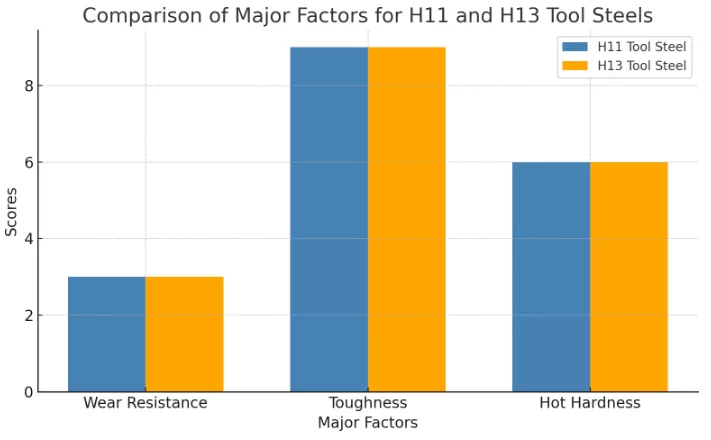
- Resistencia al desgaste: H11 y H13 tienen el mismo valor de 3, lo que indica la misma resistencia al desgaste.
- Tenacidad: Ambos tienen un valor de 9, lo que sugiere una alta tenacidad para ambos tipos.
- Dureza en caliente: Ambos tienen el mismo valor de 6, lo que indica propiedades de dureza en caliente similares.
Según esta tabla, H11 y H13 parecen tener propiedades muy similares en resistencia al desgaste, tenacidad y dureza en caliente.
Comparación de factores de fabricación para aceros para herramientas H11 y H13
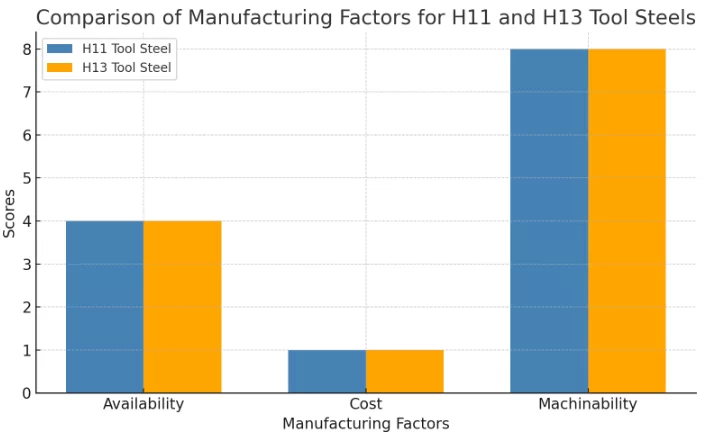
- Disponibilidad: Tanto el acero para herramientas H11 como el H13 tienen un índice de disponibilidad de 4, lo que sugiere que están igualmente disponibles.
- Costo: Ambos tipos de acero tienen una calificación de costo de 1, lo que indica que tienen precios similares.
- Maquinabilidad: Tanto el H11 como el H13 tienen una clasificación de maquinabilidad de 8, lo que sugiere que ambos son relativamente fáciles de mecanizar.
La tabla muestra que los aceros para herramientas H11 y H13 son similares con respecto a estos tres factores de fabricación.
Comparación de otros parámetros
| Factor | Aceros para herramientas H11 | Aceros para herramientas H13 |
| Dureza de trabajo habitual, HRC | 38-55 | 40-53 |
| Profundidad de endurecimiento | D | D |
| Tamaño de grano más fino con dureza total, estándar Shepherd | 8 | 8 |
| Dureza superficial en estado templado, HRC | 53-55 | 51-54 |
| Dureza del núcleo (25 mm o 1 pulg. de diámetro redondo), HRC | 53-55 | 51-54 |
| Medio de extinción | A | A |
| Temperatura de endurecimiento, °C (°F) | 995-1025 (1825-1875) | 995-1040 (1825-1900) |
| Cambio dimensional durante el endurecimiento | Yo | Yo |
| Seguridad en el endurecimiento | H | H |
| Susceptibilidad a la descarburación | H | H |
| Dureza aproximada en estado laminado o forjado, HB | 500 | 500 |
| Dureza recocida, HB | 192-229 | 192-229 |
| Temperatura de recocido, °C (°F) | 845-900 (1550-1650) | 845-900 (1550-1650) |
| Rango de templado, °C (°F) | 540-650 (1000-1200) | 540-650 (1000-1200) |
| Temperatura de forja, °C (°F) | 1065-1150 (1950-2100) | 1065-1150 (1950-2100) |
Los aceros para herramientas H11 y H13 comparten muchas similitudes en cuanto a sus propiedades mecánicas, tratamiento térmico Características y capacidades de forjado. La principal diferencia radica en su rango de dureza, donde el H13 ofrece una dureza ligeramente superior para aplicaciones más exigentes. La elección entre estos dos aceros depende de los requisitos específicos de la aplicación prevista, como la resistencia al desgaste, la tenacidad y la estabilidad dimensional requeridas.
Propiedades de tracción de los aceros para herramientas H11 y H13 a temperaturas elevadas
| Tipo de acero | Temperatura de prueba (°C) | Temperatura de prueba (°F) | Resistencia a la tracción (MPa) | Resistencia a la tracción (ksi) | Límite elástico (desplazamiento de 0,21 TP3T) (MPa) | Límite elástico (desplazamiento de 0,21 TP3T) (ksi) | Alargamiento (50 mm) (%) | Reducción de área (%) | Dureza a temperatura ambiente (HRC) antes pruebas | Dureza a temperatura ambiente (HRC) después pruebas |
| H11 | Habitación | Habitación | 1806 | 262 | 1482 | 215 | 10 | 35.8 | 50 | 50 |
| 150 | 300 | 1689 | 245 | 1358 | 197 | 10.1 | 36.1 | 50 | 50 | |
| 260 | 500 | 1600 | 232 | 1345 | 195 | 9.8 | 34.5 | 50 | 50 | |
| 345 | 650 | 1579 | 229 | 1317 | 191 | 10 | 35.2 | 50 | 50 | |
| 425 | 800 | 1510 | 219 | 1289 | 187 | 11.4 | 38.7 | 50 | 50 | |
| 480 | 900 | 1427 | 207 | 1145 | 166 | 12.2 | 38.9 | 50 | 50 | |
| 540 | 1000 | 1241 | 180 | 965 | 140 | 11 | 35.4 | 50 | 50 | |
| 595 | 1100 | 979 | 142 | 724 | 105 | 12.8 | 46.2 | 50 | 47 | |
| 650 | 1200 | 586 | 85 | 434 | 63 | 18.9 | 66.6 | 50 | 41 | |
| H13 | 480 | 900 | 1531 | 222 | – | – | 9 | 37 | 52 | – |
| 540 | 1000 | 1413 | 205 | – | – | 11 | 43 | 52 | – | |
| 595 | 1100 | 1193 | 173 | – | – | 15 | 49 | 52 | – | |
| 650 | 1200 | 814 | 118 | – | – | 22 | 59 | 52 | – |
Nota:
- El “-” en las columnas de límite elástico del acero H13 indica que los datos no estaban disponibles.
- La columna de dureza a temperatura ambiente (HRC) muestra valores antes y después de la prueba, separados por una coma.
- Datos de Teledyne VASCO, Allegheny Ludlum Industries y Universal-Cyclops Steel Corp.
Tenacidad al impacto CVN de aceros para herramientas H11 y H13 en función de la temperatura de prueba.
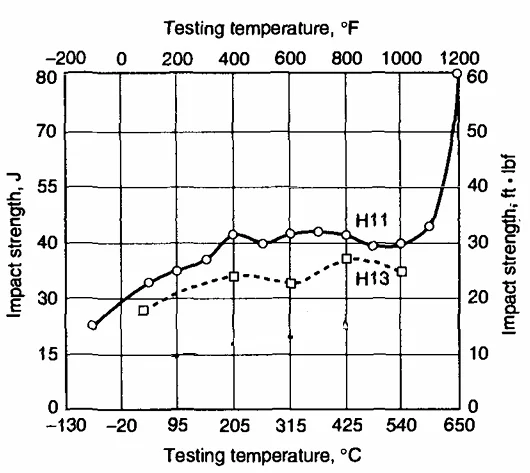
Este gráfico sugiere que el H11 y el H13 se vuelven más resistentes al impacto a temperaturas más altas. Sin embargo, el H13 es más sensible a los cambios de temperatura, mostrando un aumento más significativo en la resistencia al impacto con el aumento de la temperatura.

